THE SEARCH FOR A RADICAL FLANK
The Womens' Movement and the 1984 Democratic & Republican Conventions
by Jo Freeman
Published in off our backs, February 1985.
 If I had any doubts about how profound an impact the women's movement has had on this country, they were assuaged by going to the 1984 Democratic Convention in San Francisco (see photos). If I then had any doubts about how far we still have to go, they were removed went I went to the 1984 Republican Convention in Dallas (see photos). The major parties have often been criticized for offering no real choices to the American people. This year they offered a real choice on many things, not the least of which is their attitude toward women. It can be summed up very easily.
If I had any doubts about how profound an impact the women's movement has had on this country, they were assuaged by going to the 1984 Democratic Convention in San Francisco (see photos). If I then had any doubts about how far we still have to go, they were removed went I went to the 1984 Republican Convention in Dallas (see photos). The major parties have often been criticized for offering no real choices to the American people. This year they offered a real choice on many things, not the least of which is their attitude toward women. It can be summed up very easily.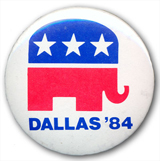 The Democrats have adopted the feminist perspective on all public issues directly affecting women and take feminist concerns seriously. They may not put them all into practice. They may not be aware of all the ramifications of feminism. And they probably don't understand what feminism is really about. But at least on public issues, and the underlying assumptions behind them, they say the right things and don't do the wrong things. The Republican Party has gone in the opposite direction. It's public script is written by Phyllis Schlafly, and its practices are not ones she would disapprove of.
The Democrats have adopted the feminist perspective on all public issues directly affecting women and take feminist concerns seriously. They may not put them all into practice. They may not be aware of all the ramifications of feminism. And they probably don't understand what feminism is really about. But at least on public issues, and the underlying assumptions behind them, they say the right things and don't do the wrong things. The Republican Party has gone in the opposite direction. It's public script is written by Phyllis Schlafly, and its practices are not ones she would disapprove of.
Although feminist issues have frequently been partisan in nature this is the first time that the Democratic Party has been so highly identified with feminists and feminist positions. Traditionally, the Republican Party was more likely to support those issues identified as feminist and the Democratic Party more likely to oppose them. Prior to the formation of the National Women's Political Caucus in 1971 what feminist pressure there was largely came from individuals, not organizations, and was largely aimed at getting political appointments for women, not changing public policy. NOW, 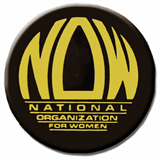 founded only in 1966, lobbied the government but was not active within or on the parties. The National Woman's Party, which had carried the burden and the banner of the Equal Rights Amendment since 1923, had members active in the parties but was not itself a force on them. Their members were more likely to be Republicans than Democrats because that party was traditionally thought to be the party of equal rights. The Suffrage Amendment was passed in 1919 by a Republican Congress, and 29 of the first 36 states to ratify it had Republican legislatures. As late as 1916 the Democrats favored state by state suffrage rather than a federal amendment. A Republican, Sen. Charles Curtis (R. Kan.), had been the ERA's first sponsor and Herbert Hoover was the only Presidential candidate to receive the NWP's endorsement (Curtis was his VP). Indeed, the only Democratic President who has ever publicly supported the ERA was Jimmy Carter.
founded only in 1966, lobbied the government but was not active within or on the parties. The National Woman's Party, which had carried the burden and the banner of the Equal Rights Amendment since 1923, had members active in the parties but was not itself a force on them. Their members were more likely to be Republicans than Democrats because that party was traditionally thought to be the party of equal rights. The Suffrage Amendment was passed in 1919 by a Republican Congress, and 29 of the first 36 states to ratify it had Republican legislatures. As late as 1916 the Democrats favored state by state suffrage rather than a federal amendment. A Republican, Sen. Charles Curtis (R. Kan.), had been the ERA's first sponsor and Herbert Hoover was the only Presidential candidate to receive the NWP's endorsement (Curtis was his VP). Indeed, the only Democratic President who has ever publicly supported the ERA was Jimmy Carter.
![]() Between the Suffrage Movement and the women's liberation movement the paramount feminist issue was the ERA. During most of its history the it was perceived as a class issue as well. It was argued that requiring equal rights under law would favor upper class professional and executive women at the expense of working class women who needed legal protections in the form of laws which governed their working conditions and frequently restricted the hours they could work and the weight they could lift. Since the Democratic Party viewed itself as the party of the working man (sic), and virtually all labor unions opposed the ERA, all but a few politically active women in the Democratic party did so as well. This began to change after 1969, when Libbie Koontz was appointed to head the Women's Bureau by Nixon even though she was a Democrat. She had headed the National Education Association, which had supported the ERA. She persuaded many women union leaders to support the ERA and they in turn worked on the men.
Between the Suffrage Movement and the women's liberation movement the paramount feminist issue was the ERA. During most of its history the it was perceived as a class issue as well. It was argued that requiring equal rights under law would favor upper class professional and executive women at the expense of working class women who needed legal protections in the form of laws which governed their working conditions and frequently restricted the hours they could work and the weight they could lift. Since the Democratic Party viewed itself as the party of the working man (sic), and virtually all labor unions opposed the ERA, all but a few politically active women in the Democratic party did so as well. This began to change after 1969, when Libbie Koontz was appointed to head the Women's Bureau by Nixon even though she was a Democrat. She had headed the National Education Association, which had supported the ERA. She persuaded many women union leaders to support the ERA and they in turn worked on the men.
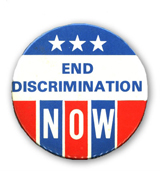 After the Civil Rights Act passed in 1964 many working class women filed cases in federal court challenging their employers' right to deny them jobs or promotions based on restrictions in State protective laws. The courts consistently abolished these laws, and by so doing undermined the main opposition to the ERA. Although the AFL-CIO did not officially support the ERA until 1973 its opposition waned sufficiently after 1970 that the ERA ceased to be a partisan issue until Phyllis Schlafly formed STOP-ERA in 1973. What opposition there was to the other women's rights legislation passed in the early seventies was also not partisan in nature.
After the Civil Rights Act passed in 1964 many working class women filed cases in federal court challenging their employers' right to deny them jobs or promotions based on restrictions in State protective laws. The courts consistently abolished these laws, and by so doing undermined the main opposition to the ERA. Although the AFL-CIO did not officially support the ERA until 1973 its opposition waned sufficiently after 1970 that the ERA ceased to be a partisan issue until Phyllis Schlafly formed STOP-ERA in 1973. What opposition there was to the other women's rights legislation passed in the early seventies was also not partisan in nature.
The first success within the major political parties of the contemporary, organized women's movement came with an increase in women delegates to the National Party Conventions between 1968 and 1972 of 13 to 40 percent for the Democrats and 17 to 30 percent for the Republicans. Its first failure was the refusal of the 1972 Democratic Convention to support a minority report to the Platform in favor of choice (which didn't even mention the word "abortion"). Without much fanfare both Democratic and Republican women succeeded in reinstating support for the Equal Rights Amendment into their party platforms. The Republican Party first supported it in 1940, but took out mention of the ERA in its 1964 and 1968 platforms. The Democratic Party, where the ERA had always been a much more controversial issue, did not support it until 1944, and took it out in 1960.
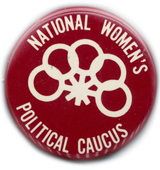 In 1972 individual feminists were equally active but a bit less powerless in the Republican than the Democratic Parties. Power in the Republican Party has been based on who you know and who you are while that in the Democratic Party is derived from who you represent. There were several strong feminists within the Republican Party who, because of their personal connections to important people, could influence the Party at least on those things which were not controversial (i.e. the ERA). Thus they were able to persuade the Platform Committee to include a more comprehensive plank on women than any previous ones, and to strengthen the rules slightly to urge the State parties "to endeavor to have equal representation" at future Conventions. Feminists within the Democratic Party had to build up a power base of women active in the Party whom they could legitimately claim to represent before they could have much of an impact. This wasn't accomplished until 1976. In 1972 their claims to representation were tenuous. However, one consequence of the much derided party reforms was to bring new activists into the Democratic Party who were also sympathetic to feminism. Thus, while the rules requiring demographic representation were weakened for the 1976 convention, the NWPC was able to locate supporters and begin building a base.
In 1972 individual feminists were equally active but a bit less powerless in the Republican than the Democratic Parties. Power in the Republican Party has been based on who you know and who you are while that in the Democratic Party is derived from who you represent. There were several strong feminists within the Republican Party who, because of their personal connections to important people, could influence the Party at least on those things which were not controversial (i.e. the ERA). Thus they were able to persuade the Platform Committee to include a more comprehensive plank on women than any previous ones, and to strengthen the rules slightly to urge the State parties "to endeavor to have equal representation" at future Conventions. Feminists within the Democratic Party had to build up a power base of women active in the Party whom they could legitimately claim to represent before they could have much of an impact. This wasn't accomplished until 1976. In 1972 their claims to representation were tenuous. However, one consequence of the much derided party reforms was to bring new activists into the Democratic Party who were also sympathetic to feminism. Thus, while the rules requiring demographic representation were weakened for the 1976 convention, the NWPC was able to locate supporters and begin building a base.
By the 1976 Conventions the stage had been set for major battles over women's issues by both Republicans and Democrats, but they were very different battles. In the Democratic Party feminists fought for power independently of other struggles going on within the Party. In the Republican Party feminists fought for the ERA as part of the contest between Reagan and Ford. In the Democratic Party, feminists lost their battle but won the war. Feminists in the Republican Party did the opposite.
The fight within the Democratic Party was over the "50-50" rule which mandated that from 1980 on all delegations would have to be half women. This change was proposed because there had been a sharp fall off of women delegates from 40 to 34 percent at 1976 Convention. The Carter campaign controlled a majority of the votes and did not support the 50-50 rule. However, neither did it want a bloody floor fight in a year in which the Democrats sensed victory. After several days of negotiations Carter compromised by agreeing to promote equal division in future conventions. More important than victory was the opportunity feminists, in particular the NWPC, had to demonstrate their power and the legitimacy of their claim to represent Democratic women. It did this by joining with the Women's Caucus of the Democratic National Committee, headed by Koryne Horbal, to hold daily meetings open to both delegates and non-delegates to ratify the decisions reached in negotiations with the Carter campaign. NOW was an outsider to the negotiations and had few members as delegates, but its members did voice their support for a floor fight as non-delegates at the women's caucus meetings, and circulated a petition on the ERA for delegates to sign.
In the winter of 1978 rules for the mid-term convention were changed to require equal division and at this meeting the Democratic National Committee, at the urging of Carter operatives, amended the 1980 convention "call" to also require it. They knew that if they didn't, equal division in each candidate's delegations would be an issue in 1980, when Carter faced potential opposition from Ted Kennedy. The Carter Administration pre-empted this issue by co-opting it.
Feminists at the 1976 Republican Convention held only one meeting for delegates, the day before the Convention began. It's purpose was to provide information, not obtain ratification, and it was attended by few women delegates and a few more press. While Democratic politics are open, loud, and confrontational, those of the Republicans are closed, quiet and consensual. Thus feminist activity at the Republican Convention consisted of four women with close personal ties to the Ford campaigns, who operated as the Republican Women's Task Force of the National Women's Political Caucus, quietly lobbying to retain the ERA in the Platform. The ERA won by only one vote in the relevant Platform subcommittee, but because Ford supported and Reagan opposed it Ford campaign operatives kept their members on the Platform Committee in line and the ERA was retained. Opponents did have enough votes for a minority report, but were dissuaded by Reagan operatives from bringing the ERA to the floor because he wanted floor fights only on two issues and removing the ERA was not one of them.
In 1980 there was a good deal of tension between feminists and both parties. In the Republican Party the Reagan campaign was completely in charge; none of the women involved in the Republican Women's Task Force of the NWPC had any personal ties to his campaign. Since Republicans don't organize caucuses, they had no alternative power base among the 36 percent of the delegates who were women. (Even if the Republican Party did have delegate caucuses it's doubtful the women would have been feminists. Schlafly's influence was quite strong by then). Consequently feminist influence was negligible. The right had no trouble in removing the ERA from the Republican Platform and proposing a Constitutional amendment to ban abortion and a requirement that only federal judges who opposed abortion be appointed.
Despite these defeats Republican feminists are also Republican loyalists so several prominent supporters of choice and the ERA put together a Women's Policy Advisory Board to help sell Ronald Reagan to American women. This incurred the wrath of Phyllis Schlafly, who thought it was a feminist plot. She asked the Reagan campaign to abolish it and when that wasn't done, pulled her Eagle Forum supporters from their volunteer posts in numerous Reagan campaign offices, leaving some unable to get their phones answered. They were returned after a compromise in which one of her lieutenants, Elaine Donnally, was put on the Women's Board and a separate Board on Family Policy was created for Schlafly supporters.
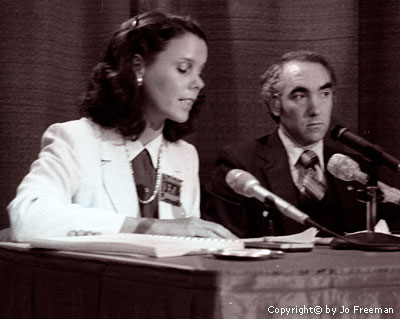 Elaine Donnally |
The tension within the Democratic party, manifested itself in separate meetings for women delegates called by the Women's Caucus of the Democratic National Committee and a feminist coalition of NOW, the NWPC and prominent feminists such as Bella Abzug and Gloria Steinem. NOW had voted to not support Carter the year before because it was unimpressed with his efforts for the ERA. Even before this there had been quite an uproar when he fired Abzug from the Women's Advisory Commission so the Carter campaign just assumed all feminists were Kennedy supporters. The issue over which the confrontation between the Carter campaign and feminist forces was waged was Minority Report No. 10 to the Platform Committee -- a proposal to deny Democratic Party funds to any candidate who did not support the ERA. This was one of several proposals drawn up by NOW for the Kennedy campaign. Many feminists thought it was a pretty silly issue, as the Democratic Party has little money to give candidates and was not known for enforcing a party line on any issue, but NOW argued that to reject No. 10 would play in the press as a rejection of the ERA.
Since several minority reports were to be debated on the floor, the Carter campaign was not reluctant to engage in a public fight as it had been in 1976 and made no effort to negotiate a settlement. Instead Carter operatives "whipped down" the proposal (i.e. told their delegates not to support it) but women delegates, few of whom had gone to the feminist delegate meetings, revolted. The largest single group of Carter delegates at the 1980 Convention were members of the National Education Association. When they told the Carter campaign that they were going to support No. 10, Carter backed down. Tip O'Neill called for a voice vote of the Convention without debate and deemed it passed.
Whether what happened at the 1980 Conventions had any effect on the vote in November will never be established. Despite Reagan's repeated declaration that he supported equal rights for women he and the Republican Party were identified as anti ERA and the Democratic Party as pro ERA. That fall, for the first time in history, there was a statistically significant gap (8 percent) in the way men and women voted for President. More men voted for Reagan than for Carter while women evenly split their vote between the two. The gender gap continued throughout Reagan's Presidency and spread into attitudes toward the Republican Party. Surveys consistently showed that for every question in which Reagan's name appeared, women were more negative. The 1982 elections showed more women than men voted Democratic. The data do not show that this antagonism correlates with respondents' positions on the ERA and abortion.
The 1984 Democratic Convention
The fact that feminists had displayed so much clout in 1980 gave them an inside spot in the 1984 race with the consequence that there was very little for them to do at the Convention itself. All the candidates trooped to San Antonio, Texas in July 1983 to seek support from those attending the NWPC convention. When NOW announced it would endorse a Democratic Party candidate for President, it was courted by all. Six candidates were invited to address the NOW National Conference in October. Askew was not invited because of his anti-choice stand and Jackson had not yet declared his candidacy.
Although most observers expected Mondale to get the NOW endorsement, the officers drew up four criteria and met with five of the candidates -- Mondale, Cranston, Glenn, Hart and Jackson.
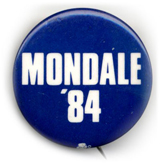
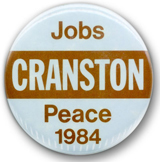
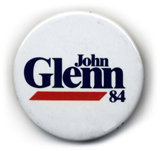
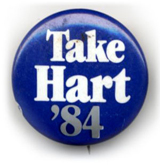
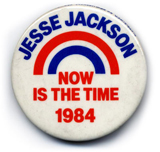
Each was also given lists of National Board members and State Chairs so he could lobby NOW. The four criteria were the
1) candidate's position on and priority of women's issues,
2) number of women in key staff positions,
3) 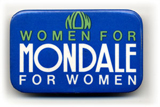 willingness to select a women Vice President, and
willingness to select a women Vice President, and
4) electability.
There was some movement within NOW to withdraw the decision to endorse, but the NOW leadership felt strongly that endorsing Mondale was the way to go and persuaded everyone else to go along. 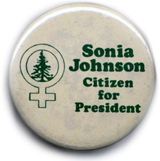 At the December Board meeting an initial straw poll gave Mondale 25 votes to 12 for Cranston. A motion to endorse Mondale then passed by 32 to 5. Once the decision was made virtually no active NOW members supported any other Presidential candidate. The few who did largely supported Sonia Johnson in her bid for the Citizens Party nomination.
At the December Board meeting an initial straw poll gave Mondale 25 votes to 12 for Cranston. A motion to endorse Mondale then passed by 32 to 5. Once the decision was made virtually no active NOW members supported any other Presidential candidate. The few who did largely supported Sonia Johnson in her bid for the Citizens Party nomination.
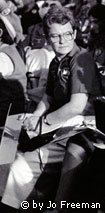 Mary Jean Collins |
In the Spring, representatives from feminist and women's organizations, and politically active women, held several meetings to plan their actions at the convention. Although the platform had not been finalized it appeared that feminist minority planks would not be necessary because the Mondale campaign was prepared to give them everything they wanted. NOW Action Vice President Mary Jean Collins was appointed to the drafting committee by DNC Chair Chuck Manatt at the behest of the Mondale campaign and had "sign off" authority on all language of concern to NOW.
Therefore the incipient women's caucus decided that their focus should be on persuading Mondale to choose a woman Vice Presidential nominee, though they were uncertain on whether to force a floor fight should these efforts fail. Delegate surveys showed that there was considerable support for such a move and voter polls indicated that a woman would probably help the Democratic ticket more than hurt it. .jpg) Therefore public and party officials were lobbied to put pressure on Mondale, helpful information was leaked to the press, and 150 delegates willing to be whips were identified and organized. It was also agreed that this time there would be only one women's caucus at the convention, at which everyone would be organized for the Vice Presidential selection. (Usually the Presidential candidate doesn't announce his VP choice until after formal nomination the third day of the convention).
Therefore public and party officials were lobbied to put pressure on Mondale, helpful information was leaked to the press, and 150 delegates willing to be whips were identified and organized. It was also agreed that this time there would be only one women's caucus at the convention, at which everyone would be organized for the Vice Presidential selection. (Usually the Presidential candidate doesn't announce his VP choice until after formal nomination the third day of the convention).
The coalition had a short list of acceptable women it thought Mondale should choose from but it had not singled one out. That was done by three Congresswomen, Barbara Mikulski (Md.), Mary Rose Oakar (Ohio) and Barbara Kennelly (Conn.), when they endorsed Geraldine Ferraro the night before the NOW National Conference in June. That conference passed a resolution to put the name of a woman in nomination for Vice President at the Democratic Convention "if necessary" without spelling out what that meant.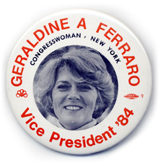 Ferraro told the press that she would permit her name to be put into nomination as a "statement" if no other woman was nominated. On July 4, 23 feminists and elected women officials met with Mondale to add their support for a woman running mate.
Ferraro told the press that she would permit her name to be put into nomination as a "statement" if no other woman was nominated. On July 4, 23 feminists and elected women officials met with Mondale to add their support for a woman running mate.
After Mondale announced his choice of Geraldine Ferraro on July 12, the coalition dismantled their whip system. This upset the Jackson campaign as he had hoped it would be used to support his platform minority planks. A meeting of the women's caucus had voted favorably on Jackson's proposals, but it was not a binding vote, and was not solely by delegates. The women's caucus leadership felt its whips had been recruited solely to work on the Vice Presidential nomination and could not be directed elsewhere. NOW had also identified its delegates and independently organized some of them as whips. It did support Jackson's efforts but to no avail.
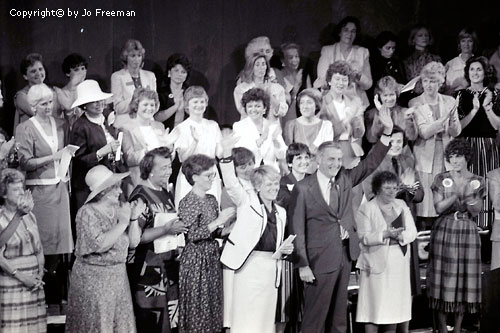
Because feminists got pretty much everything they wanted prior to the Democratic Convention, there wasn't much to do there except celebrate.
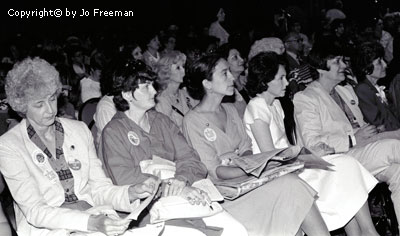
Nonetheless a women's caucus met every day to listen to feminist
speakers, the candidates, and to debate the minority planks.
Throughout these meetings, I had the feeling that something was missing. There was so much celebration of Ferraro's nomination, and NOW, the most radical feminist group there, was so thoroughly incorporated into the mainstream, that the question of a future agenda was never broached. What was missing was a radical flank.
A good radical flank is an essential ingredient to steady social change. Someone, or something, who has nothing to gain by playing the insiders' game must regularly raise new issues and expound new analyses in order to pull the mainstream in a progressive direction. However a radical flank by itself moves very little. There must be people on the inside receptive to the message who can be persuaded to agitate from within. And those agitating on the outside must not be so alienated, or so radical, that they cannot deal with the political system at all.
Throughout most of the history of the women's movement there has been a good combination of insiders and outsiders. In the early days when all avowedly feminist groups were outsiders, there were plenty of closet feminists in influential positions in the government who could take advantage of the opportunities the newly emerging feminist constituency created. Similarly, the existence of small feminist groups, many of which were developing feminist analysis and applying it to new areas of life, provided a constant source of ideas and pressure on the more established national feminist organizations. In the mid seventies the small groups began to encapsulate into feminist communities and loose many of their connections to the larger feminist groups. Simultaneously, the national organizations demanded participation in the mainstream, and to judge by appearances at the 1984 Democratic Convention, have succeeded in becoming a working partner with at least the liberal portion of it.
But there is always a price for participating in the mainstream: one must abide by the inevitable requirement that one curb one's commitment to one's own agenda. The rules of the game require that one not make too many demands or ones that are too radical or that seriously conflict with the goals of other coalition groups. If the national organizations don't know this by now, they will find out eventually. Indeed, the NWPC does know the rules for insiders, which it implicitly followed by dismantling its whip system rather than permit it to be used by the dissident Jackson forces. The fact that NOW did not may mean that it has not yet learned the constraints of joining the mainstream, or may indicate that it thought it more desirable to earn points with Jackson forces. It may also reflect a residual attraction of the outsider role that NOW has played at past Democratic conventions; a role that permits allegiance to "principle" to take precedence over political exigencies. If so, what NOW must learn next is that one cannot be both an insider and an outsider; a mainstream participant and the radical flank. Both functions are important to achieving social change but they must be kept separate. Any person or organization trying to do both loses credibility and legitimacy. Thus, if NOW wants to be part of the mainstream what it and the rest of the women's movement needs most, in order to maintain pressure from within, is a good radical flank. It needs constant criticism, tempered with understanding of political reality, from outsiders.
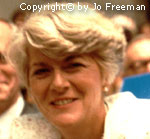 By the end of the Democratic Convention I found myself both pleased and troubled. Pleased that committed feminists and a solid feminist agenda had been incorporated into the mainstream of the Democratic Party. And troubled that the absence of any radical flank would temper future progress. One month later I went to the Republican Convention in Dallas and came to a very different conclusion. In this country, in the mid 1980s, the Democratic Party is the radical flank.
By the end of the Democratic Convention I found myself both pleased and troubled. Pleased that committed feminists and a solid feminist agenda had been incorporated into the mainstream of the Democratic Party. And troubled that the absence of any radical flank would temper future progress. One month later I went to the Republican Convention in Dallas and came to a very different conclusion. In this country, in the mid 1980s, the Democratic Party is the radical flank.
The 1984 Republican Convention
Both NOW and the NWPC had given up on the Republicans even before the Convention. They planned no actions. NOW sent executive Vice President Lois Reckitt as an observer. Kathy Wilson, President of the NWPC and a liberal Republican, gave a press conference and released a fifty-page document refuting Party claims that women are better off than they were four years ago. NOW and the NWPC made this decision because they felt the right had so thoroughly taken over the Republican Party that they could not get a hearing. That observation was certainly correct. Even the Republican Mainstream Committee, composed of a small group of liberal Republicans who sponsored Wilson's press conference as part of its convention program, was treated with disdain.
This year the Republican Party did not hold hearings on its Platform, but it did accept testimony one day prior to deliberations by the various subcommittees. (The Convention Committees meet the week before the Convention). At these, persons testifying in opposition to key right wing planks found themselves barraged with questions about the Democratic ticket rather than the subject on which they testified. When Mary Louise Smith, former chair of the Republican National Committee, and Mary Stanley, a long-term Reagan supporter from California who currently heads Republican activities in the NWPC, testified in favor of the ERA, they were cross examined on Geraldine Ferraro's finances.
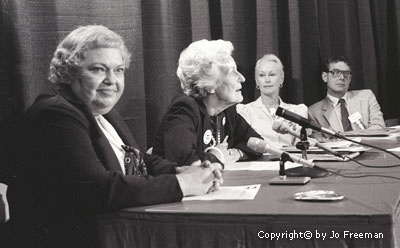 Mary Stanley - Mary Louise Smith |
Yet by deciding to do nothing more at the Republican Convention NOW and the NWPC also declared that they would not participate in Party politics unless they could do so as insiders, or at least as respected outsiders. In 1976 and 1980 NOW demonstrated outside the Convention while the RWTF acted, or tried to act, within. NOW was the radical flank, though its reluctance to accept this role was evident. In 1976, NOW President Karen DeCrow acceded to the RWTF's request to leave town after the march in order not to contaminate the efforts of Republican feminists with the pinkish taint of radicalism that they said the NOW label meant in the Republican Party. NOW's and the NWPC's reluctance to insist on a feminist presence in the hostile Republican environment reinforced the Party's belief that both organizations are merely arms of the Democratic Party, and as such can be dismissed as irrevocably partisan.
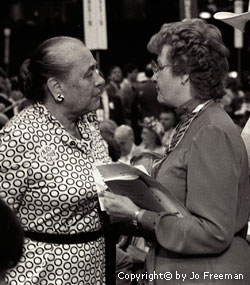 Betty Rendel |
Feminists may have been in hiding during the 1984 Republican National Convention, but the influence of the women's movement was pervasive. This influence was not seen in the content of the convention so much as in the quantity of attention paid to women. Although the Republican Party does not require that half of the delegates be women as the Democrats do, 48 percent of the delegates and 52 percent of the alternates were female. Betty Rendel, President of the independent National Federation of Republican Women disavowed the Democratic quota system as "artificial, discriminatory and... a little silly," while describing the way in which Republican women 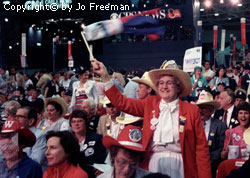 were cajoled into running for delegate spots and men discouraged by top party leaders, including the President. She said Party leaders had to exert steady pressure to persuade men originally selected as delegates to step aside for the "envelope stuffers and precinct walkers."
were cajoled into running for delegate spots and men discouraged by top party leaders, including the President. She said Party leaders had to exert steady pressure to persuade men originally selected as delegates to step aside for the "envelope stuffers and precinct walkers."
One-third of the major speakers were women, including keynoter Katherine Davalos Ortega. With the exception of U.N. Ambassador Jeane Kirkpatrick, who got a longer and louder floor demonstration than any other speaker apart from Reagan even though she is a registered Democrat, their message was highly consistent. Each extolled President Reagan for appointing the "first woman to...." and then went on to say that she had not achieved her position because she was a woman but because of her exertions and her merit. The implication was that in the last four years the Republican Party has sprouted a lot of qualified women where none existed before.
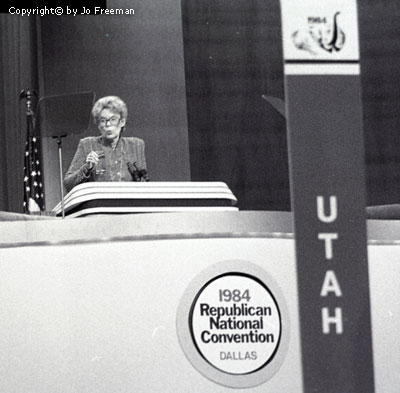 Jeane Kirkpatrick |
For the first time the Republican Convention had a large booth in the press area solely to provide information on women. The Republican Women Information Services also set up interviews and sponsored or advertised receptions, luncheons and breakfasts aimed at women. The Women's Division of the Republican Party, since its re-creation in April of 1983, has sponsored several projects aimed at women. These include the National Women's Coalition "of professional and activist women drawn from business, the arts, academia, the sports world and politics," numerous conferences and briefings to form women's networks, develop candidates and prepare speakers and the release of reams of material on what the Republican Party and Ronald Reagan have done for women.
Delegate surveys by several newspapers indicated that by and large, Republican women delegates took the same positions as did men. The two exceptions were a Constitutional amendment to prohibit abortions and the use of military force, which men favored more than women by a margin of ten percent. Women were also more favorably impressed by the women on a list of prominent politicians than were men -- also by an average of ten percent.
Although the content was not what feminists would prefer, women and women's issues occupied a larger portion of the Platform than anytime since women got the vote. However, the slant was largely dictated by the Moral Majority and Phyllis Schlafly whose Eagle Forum supporters were much in evidence. Schlafly was the only person to come out of the decade long ERA struggle with a personal power base. The Eagle Forum claims 60,000 members and all of its officers are appointed by Schlafly. Most of the planks relevant to women were discussed by the Human Resources Subcommittee. Schlafly sat on the National Security subcommittee but her lieutenant, Elaine Donnelly, acted as liaison between her and Human Resources member Jean Ashbrook of Oregon, who moved amendments in accordance with Schlafly's instructions.
The Equal Rights Amendment was not mentioned in either the draft or the final version of the Platform. Schlafly was not scheduled to speak against it, but decided spontaneously to do so when she discovered no else planned to either. She declared it as "dead as prohibition." Mary Louise Smith and Mary Stanley made a plaintive appeal that the ERA not be excluded. Smith said it was a paradigmatic conservative Republican issue. 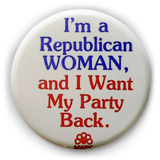 "Individual freedom and responsibility are at the soul of the women's movement and the Republican Party" she said. Stanley, with tears in her eyes, said she had been an active Republican all her life, as well as a feminist. Her Republican Party was the Party which supported the ERA, and she wanted it back. She later said that the chair of the California Republican State Committee asked her to resign her position on it because she had made favorable comments about Democratic Vice Presidential nominee Geraldine Ferraro. She did not resign at that time, but eventually was convinced to do so.
"Individual freedom and responsibility are at the soul of the women's movement and the Republican Party" she said. Stanley, with tears in her eyes, said she had been an active Republican all her life, as well as a feminist. Her Republican Party was the Party which supported the ERA, and she wanted it back. She later said that the chair of the California Republican State Committee asked her to resign her position on it because she had made favorable comments about Democratic Vice Presidential nominee Geraldine Ferraro. She did not resign at that time, but eventually was convinced to do so.
Bill Hughes of Colorado moved to add a plank endorsing the ERA, but it failed for lack of a second. This effort was repeated on Thursday before the full Committee where it was defeated 15 to 76. Two other proposals, one to add sex to the equal protection clause of the 14th Amendment and another which merely recognized that many Party members supported the ERA, were also defeated. All motions to soften the hard-line pro-life language and the anti-comparable worth plank in the platform met similar fates. During a meeting of the full Platform Committee comparable worth was denounced as "a socialist idea" by Peggy Miller of West Virginia.
The final GOP Platform presents a very traditional image of the role of women. Most illustrative is that on welfare. Welfare -- undefined -- is accused of shattering "family cohesion," both "by providing economic incentives to set up maternal households and by usurping the breadwinner's economic role in intact families." The Republican Platform goes on to say that "the cruelest result was the maternalization of poverty, worsened by the breakdown of the family and accelerated by destructive patterns of conduct too long tolerated by permissive liberals." (Italics added).
Contained in these sentences are several assumptions. The most obvious and onerous of which is that the only proper family is one with a male breadwinner who does not share the role of economic provider. The Platform's redefinition of the feminization of poverty into the maternalization of poverty is not an idle choice of words but based on this assumption. When asked what were the solutions to this problem, a young but conservative male Congressman answered that this could be done by enforcing child support, and discouraging divorce and out-of-wedlock pregnancies. In effect he said that women should look solely to men for their economic sustenance, and not to themselves. They should also not expect government support to end discrimination and improve job opportunities.
Not surprisingly, (since it was OKed by NOW's Vice President) the Democratic Platform calls for "a renewed commitment to combat the feminization of poverty in our nation so that every American can be a productive,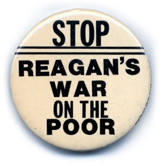 contributing member of our society." It says that what "young mothers" need is education, training, and quality child care and that what women in general should be guaranteed is not just "a place in the work force" but "an equal chance at a career leading to the board of directors." Unlike the GOP Platform, that of the Democrats supports pay equity, gay and lesbian rights, affirmative action, an end to discrimination in insurance, restoration of the Civil Rights Commission to independent status and strengthened enforcement of anti-discrimination laws.
contributing member of our society." It says that what "young mothers" need is education, training, and quality child care and that what women in general should be guaranteed is not just "a place in the work force" but "an equal chance at a career leading to the board of directors." Unlike the GOP Platform, that of the Democrats supports pay equity, gay and lesbian rights, affirmative action, an end to discrimination in insurance, restoration of the Civil Rights Commission to independent status and strengthened enforcement of anti-discrimination laws.
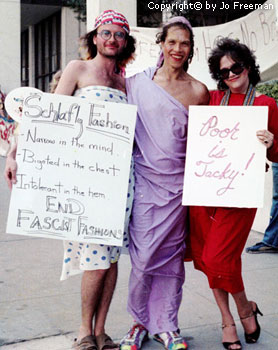 Schlafley wouldn't let me into her fashion show, so I mingled with the anti-fashion show outside |
There were no women's caucuses or any opportunity for women attending the convention, feminist or otherwise, to discuss the platform or any other issues. Republican Conventions rarely have caucuses. They have receptions. The two biggest events for women were the NFRW luncheon for Nancy Reagan, featuring Joan Rivers, and Phyllis Schlafly's fashion show. The latter attracted about 1,700 people who paid $50 each to watch the wives of prominent Republican men (including Mrs. James A Baker, Mrs. Jesse Helms, Mrs. Jack Kemp, Mrs. Paul Laxalt and Mrs. Trent Lott, as they were listed in the program) and a couple prominent women (Cong. Barbara Vucanovich and Ambassador Jean Gerard) traipse down the aisle wearing the latest Texas fashions. They were applauded in accordance with the popularity of the men to whom they were attached. Jeane Kirkpatrick said a few words, and prominent Democrats (Mondale, Ferraro and Tip O'Neill) and feminists (Steinem and Abzug) were parodied in song and costume by Republican office holders.
Outside the hotel where this event was held, Ladies Against Women, a Berkeley, California theater group, held its own fashion parade, a parody of campish fifties outfits. They held similar events outside all major Republican functions. Leaflets were passed out declaring them to be "a national group of grownup girls who have taken positions (ladylike, inferior positions) on all Republican planks." They urged that virginity be restored as a high school graduation requirement and that the gender gap be eliminated by repealing the "ladies vote."
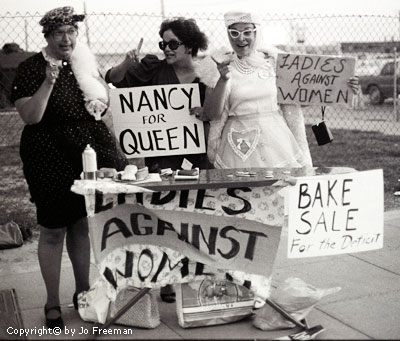 Ladies Against Women |
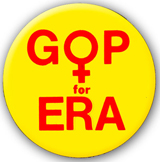 The only other feminist presence in the entire Republican Convention was in the gift boutique four miles from the convention center, where Mary Stanley was selling buttons for the NWPC. Although business was slow due to the out of the way location and the fact that delegates weren't free to shop until the third day of the proceedings, when the booths were scheduled to close, Stanley says she collected 200 names of pro-ERA Republican women. She said female delegates may not be speaking out but the most popular buttons in her stock, of which she sold several hundred, were "I want my party back", "GOP for the ERA" and "Women were not born Republicans, Democrats or Yesterday."
The only other feminist presence in the entire Republican Convention was in the gift boutique four miles from the convention center, where Mary Stanley was selling buttons for the NWPC. Although business was slow due to the out of the way location and the fact that delegates weren't free to shop until the third day of the proceedings, when the booths were scheduled to close, Stanley says she collected 200 names of pro-ERA Republican women. She said female delegates may not be speaking out but the most popular buttons in her stock, of which she sold several hundred, were "I want my party back", "GOP for the ERA" and "Women were not born Republicans, Democrats or Yesterday."
See Jo's photo pages for the:
1984 Democratic Convention
1984 Republican Convention
Books by Jo | What's New | About Jo | Photos | Political Buttons
Home | Search | Links | Contact Jo | Articles by Jo